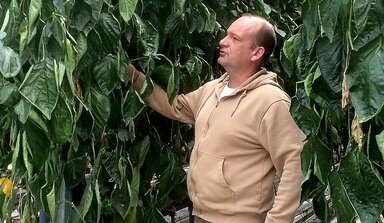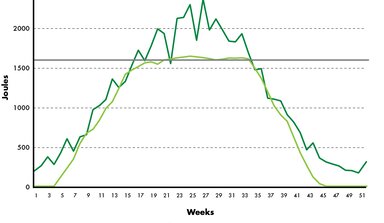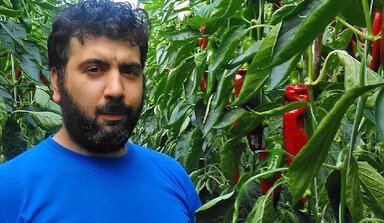Daily light integral should be guide for optimal vegetable production
Radiation is an important factor for good climate control. In addition, the daily light integral is important for the crop.
Light measurements were originally not developed for horticulture but for humans. The human eye is sensitive to roughly the same wavelengths as those in the Photosynthetically Active Radiation (PAR) range. But we see some colours better than others. This has clearly been taken into consideration for light measurements and is where the unit ‘lux’ originates. Some growers still express the strength of their assimilation lamps in lux. But this unit is not at all suitable to characterise the light used by plants.
Light consists of particles called photons. The plant experiences every particle as being equal: Each particle contributes equally to photosynthesis. Therefore, it is logical to refer to the quantity of light in number of particles. The unit used is a mole (or micromole µmol); One mole comprises an enormous number of particles, namely 6 x 1023. Because there is a constant stream of light particles it is referred to as a flux which is expressed in µmol/m2/s, so the number of particles per m2 per second.
Measuring light in the greenhouse
Measuring light in the greenhouse is not easy. Although a PAR-metre, which measures the relevant part of the light, is available, the placement of the light meter is important. Also, the light varies with the time of day and with the weather. For each crop there is an optimal light intensity at which it functions best: highest photosynthesis and least stress. If there is insufficient light, production lags behind.
So how do you know if the crop receives enough light if the intensity and the measurements always fluctuate? The daily light integral (DLI) can help answer this question. The DLI is the total amount of PAR light the crop receives on one day. Thus the amount of moles per m2 per day: mol/m2/d. Sensors are available that automatically register the DLI.
Optimal DLI
During the course of a year the DLI can vary substantially, from 2-5 mol/m2/d in low light periods in temperate regions to 25-30 mol/m2/d in the high season in regions with lots of light.
Each crop has an optimal DLI-range. If the amount of light falls below this up on any one day, not enough is produced. If it rises above this light is wasted and damage may occur. Also, the light level at any one moment makes a difference. If it rises too much, damage occurs even if the DLI remains within the limits.
Purdue University in America has carried out a lot of research on optimal DLIs. Tomato and peppers are light loving crops that can handle 20-30 mol/m2/d. An adult tomato crop requires at least 22 mol/m2/d for good productivity. Even 30 mol/m2/d is not a problem, providing the humidity is not too low. These values are slightly lower for paprika. On the other hand, 14-16 mol/m2/d is ideal for lettuce grown on substrate.
Coatings
The optimal DLI is an important issue to consider when choosing a coating for the greenhouse roof. Light loving crops need to receive a lot of light, but it is important to shade out the highest peaks to prevent damage. ReduFuse and ReduFuse IR are very suitable for this. Less shading is a good solution for vegetable crops with a lower optimal DLI.
Also, the DLI can provide guidance when making decisions about when to switch on and off the assimilation lighting. Yet often decisions about when to close a shade screen above vegetable crops are not determined by the DLI but by peaks in light intensity at a certain part in the day.


